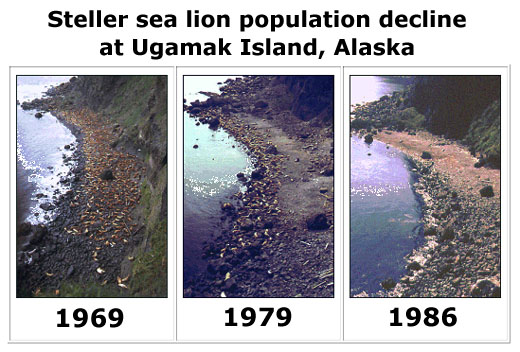Notes for Chapter 18:
Changing the Oceans by Harvesting Organisms
Click link to return to Lecture
Schedule
or Lecture Notes by Chapter
Back to Chapter 17
Forward to Chapter 19
Case History: The Fur Seals
that Weren't
Featured
Organisms:
Southern
(or S. American) sea lions
More Links: 1
- 2
- 3
- 4
- 5 - 6
- 7
- 8
Compare to South
American fur seals:
1 - 2
- 3
- 4
- 5
or southern elephant seals
RQ 18.1: What mistake did Edmund
Fanning's company
make and why did they regret it? Where
are the
Falkland Islands-?
I. Effects of Fishing on Marine Organisms and Communities
a) Effect of Fishing on Harvested Stocks
RQ 18.2: Briefly explain the typical
change observed in a
fish population's individual size distribution for a
population that starts off as unexploited and becomes
increasingly fished. At what point do fisheries
experts predict that a heavily exploited fish population
will likely collapse?
b) Effects of Fishing on Non-Target
Species
terms: groundfish
 Visit
Source of Image
Visit
Source of Image
Featured
Organisms:
Steller
sea lions More Links: 1
- 2
- 3
- 4
- 5 -
6
Northern
fur seals More Links: 1
- 2
- 3 - 4
- 5 -
6
Harbor sealsMore
Links: 1
- 2 - 3
- 4 - 5
-
6 - 7
Pollock
("seal food"/"fish sticks") More Links: 1
- 2
- 3 - 4

Visit
the Source of Above Images
RQ 18.3: Relying on the principles
addressed in review question 18.2,
explain the probable reason why steller sea lion populations have
more dramatically declined in recent decades than have harbor
seal or northern fur seal populations.
c) Effects of Drift Nets and Lost Fishing
Gear
terms: incidental
catch (by-catch), drift-net,
tans,
catcher boat, ghost
fishing
RQ 18.4: Explain the problem and
briefly characterize
the magnitude of incidental catch caused by drift-net
fishing.
II. The Marine Harvest
a) Overfishing
terms: maximum sustained yield (MSY),
tonnes (= metric tons), catch per unit effort
(CPUE)
RQ 18.5: It seems paradoxical that
a maximal total harvest of
a fisheries stock can be obtained with relatively few
fishing boats, not with many more fishing boats. Explain
why in terms of the important theory of maximum
sustained yield.
b) The Global Harvest and Maximum Sustained
Global Yield
terms: artisanal catch
RQ 18.6: According to rough estimates
of global fisheries
harvest, how close are we to a global MSY level?
What are a few reasons why simply tallying estimates of
commercial fisheries harvests worldwide are bound
to underestimate the global harvest levels?
RQ 18.7: Krill are crustaceans fed
on by baleen
whales and
other animals, especially surrounding the Antarctic
continent. These account for some of the last largely
unexploited potential sources of food for humans left
in the sea. What are a few of the many obstacles that
might make the large-scale commercial harvest of krill
difficult in the future? If their harvest was to be undertaken,
what are some possible consequences to non-target species?
c) Strategies That Offset Declines
in Established Fisheries
terms: high seas
d) Aquaculture
terms: salmon ranch, salmon hatcheries
RQ 18.8: Contrast an oyster "raft"
farm, a salmon ranch or hatchery,
and salmon pen (netcage) aquaculture with respect to how each of
these, in general terms, is a more or less efficient means of
producing protein for human consumption. Besides there relative
efficiency, what detrimental
environmental consequences might
be caused by at least one of these methods?
e) The Significance of the Marine Harvest
RQ 18.9: Briefly characterize the
harvest of marine fishes or other
marine organisms in terms of its global importance. How does
it compare with the harvest of land animals and plants in terms
of the amount harvested, the amount of protein supplied, and
its reliance on farming?
Click link to return to Lecture
Schedule
or Lecture Notes by Chapter
Back to Chapter 17
Forward to Chapter 19
This page created 5/7/01 © D.J. Eernisse, Last Modified 5/9/01
 Visit
Source of Image
Visit
Source of Image
